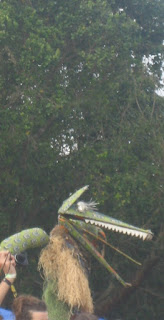Disclaimer: the
content of this website is mine alone and does not necessarily reflect the
views of the U.S. government, the Peace Corps, or the South African Government.
Over the first weekend of December I was able to witness all
of the festivities surrounding a traditional wedding in South Africa. The daughter of my next door neighbor, who is
also one of the caregivers with whom I work at the drop-in center, was getting
married. I was able to witness
everything taking place in the days surrounding the festivities, as most of the
events took place in the front yard of my neighbor’s house. The wedding took place on a Saturday. On Tuesday a tent was erected in front of my
neighbor’s home and relatives began to arrive.
On Wednesday and Thursday night church services were held in the tent,
and on Friday many family members gathered for the payment of lobola and to
cook the food that would be served the next day at the wedding.
Lobola is the tradition in which a bride price is paid by
the groom and his family. Historically
this payment was made in cattle or other animals and was a way for the groom to
thank his new in-laws for the care they took in raising the woman that was to
be his wife (makambaonline.com). The
price for lobola can be higher for different reasons, including the level of
education of the woman. The negotiation
process for lobola takes place prior to the wedding, with payment made (in this
case) the day before the ceremony. While
this matter was sorted inside of the house, the female relatives of the family
were outside cooking up a storm. There
was a flurry of activity as a bakkie (pick-up truck) full of groceries was
delivered to the yard and the women began to prepare and cook the food in
traditional crockery over an open fire.
On Saturday morning we went to the nearby church for the
ceremony. The ceremony began with the
procession first of the groom, then of the bride and her party. The bride wore a dress made of a beautiful
blue fabric. The wedding party had
different styles of dresses made with the same fabric. Vows were taken and the
bride and groom then sat in front of the church while other elements of the
ceremony took place. Three languages
were used during the ceremony: Xitsonga, Sepedi, and English, because the bride
and groom come from different language groups.
There was traditional dancing, some organized routines and some
spontaneous outbursts of dancing by the crowd.
Speeches were made by friends and family representatives, with a choir
breaking into song between each set of speeches. Cake was cut and a toast was made with a
non-alcoholic sparkling beverage. The
ceremony took about four hours (quite typical of the various events I have
attended in this region) and likely would have gone longer had the MC not
requested that speaker be brief due to the fact that it was over 100 degrees
outside and even warmer inside.
Following the ceremony everyone made their way back to the
home of my neighbor and to the yard of the home where I live. The same meal was served at both locations,
where people found places to sit outside while they ate and socialized. After about eight hours of socializing and
festivities I was spent, but the party next door was just getting started. People danced the night away, with the party
coming to an end somewhere around 2am.
The wedding was a great event that brought two families together and
gave the entire community an opportunity to celebrate with one another.










































